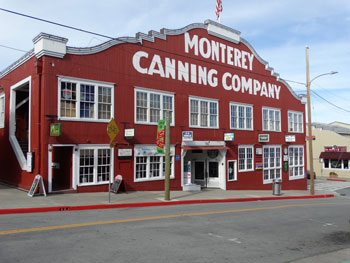
Monterey, California
by Leslie Jones
My mother tells her intriguing story of spending an entire evening dining with John Steinbeck at the family home up near Monterey in Pacific Grove, CA. A friend of hers invited her up to visit Uncle John for the weekend … little did my mother know who Uncle John was until they arrived. Walking through the garage, there were stacks of his books (in multiple languages) in every direction she turned.
If you head to Monterey’s historic Cannery Row in the middle of the week (preferably during the off-season), you might turn a bit nostalgic especially if you are a Steinbeck fan. Visuals from Cannery Row, Sweet Thursday and frequent mentions of Doc Rickett’s marine laboratory still remain. These are special characters and places I fell in love with a very long time ago.
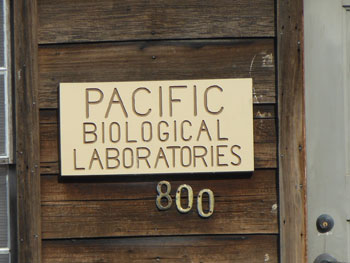 Yes, it too has changed like any popular coastal community which draws large crowds due to its unique history, natural beauty and tourist-pleasing highlights including the Monterey Bay Aquarium. But if you stare out at sea and at the nearby cannery buildings in the early morning, there are still signs of those historic sardine canning days Steinbeck spoke of so eloquently.
Yes, it too has changed like any popular coastal community which draws large crowds due to its unique history, natural beauty and tourist-pleasing highlights including the Monterey Bay Aquarium. But if you stare out at sea and at the nearby cannery buildings in the early morning, there are still signs of those historic sardine canning days Steinbeck spoke of so eloquently.
It all begins outside of the world-famous Monterey Bay Aquarium and lingers for under a mile along what is known as the Steinbeck Country Walking Tour. Bronze statues, historic buildings depicted in his captivating novels, colorful murals and memorials are all within view.
One of the most popular stops along the way is Ed Rickett’s Lab (Doc’s Western Biological Laboratories) in Steinbeck’s Cannery Row and Sweet Thursday. He moved his marine biology business here from Pacific Grove in 1928. It was in this location where Steinbeck spent many an hour philosophizing with Ricketts. It also became a favorite meeting place for artists, intellectuals and other writers including Big Sur’s colorful Henry Miller over the years.
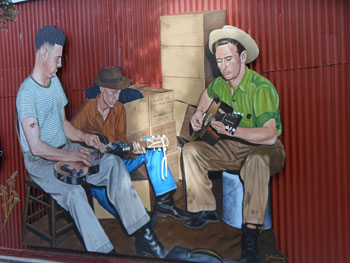 Two larger-than-life size murals based on photographs of the original “Mack and the boys” in his novel Cannery Row (who lived on the fringes of the canning district), are also nearby. Accompanied by quotations from the novel, they were created by local muralist John Cerney and lend a colorful charm to the entire area.
Two larger-than-life size murals based on photographs of the original “Mack and the boys” in his novel Cannery Row (who lived on the fringes of the canning district), are also nearby. Accompanied by quotations from the novel, they were created by local muralist John Cerney and lend a colorful charm to the entire area.
One of the most distinctive architectural artifacts still remaining from Cannery Row’s industrial era are a series of enclosed bridges called crossovers. Sixteen of these structures once carried cans packed with sardines across the street from the canning operation to warehouses near the Southern Pacific railroad tracks.
Clearly visible is the Monterey Canning Co. crossover which would have been a familiar sight to Ricketts and Steinbeck. Today, it functions as a pedestrian bridge linking shopping malls located in these former cannery and warehouse buildings.
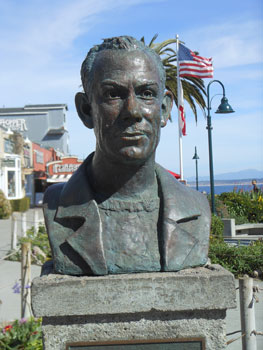 While Steinbeck Plaza has been around for awhile, a new Cannery Row Monument pays tribute to notorious, famous and colorful characters where were vital to the area’s evolution. Author Steinbeck sits atop the rock and Ed Ricketts, at the bottom, are surrounded by others who are reminiscent of what Cannery Row was like as a bustling sardine canning district. Four other men huddled together represent entrepreneurs who revived Cannery Row after it had fallen into decline. This is a poignant reminder of the vast history this area represents.
While Steinbeck Plaza has been around for awhile, a new Cannery Row Monument pays tribute to notorious, famous and colorful characters where were vital to the area’s evolution. Author Steinbeck sits atop the rock and Ed Ricketts, at the bottom, are surrounded by others who are reminiscent of what Cannery Row was like as a bustling sardine canning district. Four other men huddled together represent entrepreneurs who revived Cannery Row after it had fallen into decline. This is a poignant reminder of the vast history this area represents.
California history is so intriguing and this authentic Steinbeck setting is one of the best reminders of this historic era that you’ll find anywhere. Take your time, look beyond the shopping crowds and walk down quiet streets. You’ll feel revitalized by what you’ll discover and upon heading home, you’ll want to read Cannery Row all over again.
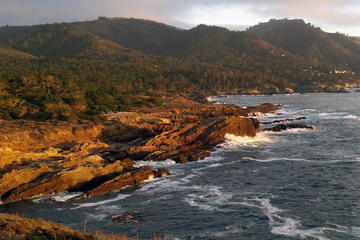
Monterey, Carmel and Big Sur Private Day Trip from San Francisco
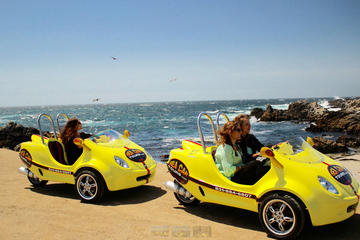
1-Hour Monterey and Cannery Row Sea Car Tour
If You Go:
National Steinbeck Center, Salinas, CA and Pacific Grove Steinbeck Tour, Pacific Grove, CA.
About the author:
Born and raised along California’s picturesque Central Coast, Leslie has lived much of her life here and is endlessly intrigued with California history. As a published writer for over 25 years, she has written much about California’s historic past. John Steinbeck, Henry Miller and Jack Kerouac are among those who have heavily influenced her ongoing writing career.
All photos are by Leslie Jones or John Hofschroer.


 But closer examination of the burgeoning urban legend reveals that McCulloch was actually a shrewd businessman with a vision and a plan. The Arizona desert land he bought was a bargain. While not situated near any major highways, it was a popular fishing destination on the banks of Lake Havasu, a 45 mile long reservoir formed when the Parker Dam was built on the Colorado River in the 1930s.
But closer examination of the burgeoning urban legend reveals that McCulloch was actually a shrewd businessman with a vision and a plan. The Arizona desert land he bought was a bargain. While not situated near any major highways, it was a popular fishing destination on the banks of Lake Havasu, a 45 mile long reservoir formed when the Parker Dam was built on the Colorado River in the 1930s.
 Two years after Mr. McCulloch’s purchase of London Bridge, I emigrated to Vancouver, Canada and forgot about London Bridge. Then in 1992 My husband and I decided to take a road trip, and were returning home from Disneyland via Las Vegas. I saw Lake Havasu City on the map and decided I simply had to see the bridge in its new home.
Two years after Mr. McCulloch’s purchase of London Bridge, I emigrated to Vancouver, Canada and forgot about London Bridge. Then in 1992 My husband and I decided to take a road trip, and were returning home from Disneyland via Las Vegas. I saw Lake Havasu City on the map and decided I simply had to see the bridge in its new home.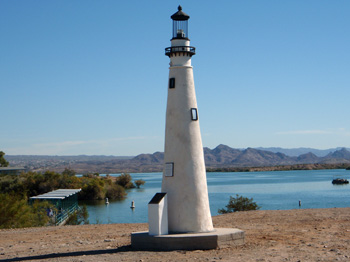 The London Bridge Interpretive Center, however, was more down to earth. It provided fascinating information about the three-year project to relocate the bridge. When the bridge was dismantled, each piece of granite was carefully numbered to indicate its position in the structure. The pieces were then shipped from London to California via the Panama Canal, from where they were trucked to Lake Havasu.
The London Bridge Interpretive Center, however, was more down to earth. It provided fascinating information about the three-year project to relocate the bridge. When the bridge was dismantled, each piece of granite was carefully numbered to indicate its position in the structure. The pieces were then shipped from London to California via the Panama Canal, from where they were trucked to Lake Havasu.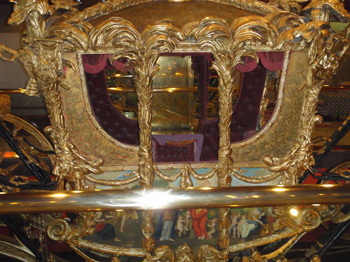 My sense that Lake Havasu was an extension of Disneyland was actually not far from the truth. To develop Lake Havasu McCulloch partnered with C.V. Wood, the president of the McCulloch Oil Corporation. Wood had previously assisted Walt Disney to develop Disneyland, and was subsequently involved in creating the first Six Flags Adventure Park. It was Mr. Wood who supervised the entire bridge moving project, and who undoubtedly gave the new planned community of Lake Havasu City its theme park flavour.
My sense that Lake Havasu was an extension of Disneyland was actually not far from the truth. To develop Lake Havasu McCulloch partnered with C.V. Wood, the president of the McCulloch Oil Corporation. Wood had previously assisted Walt Disney to develop Disneyland, and was subsequently involved in creating the first Six Flags Adventure Park. It was Mr. Wood who supervised the entire bridge moving project, and who undoubtedly gave the new planned community of Lake Havasu City its theme park flavour.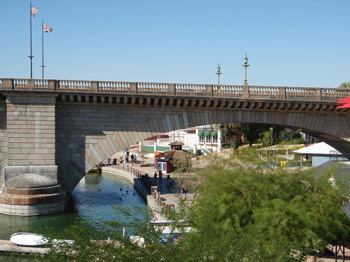 I returned to Lake Havasu in 2014. The population of Lake Havasu has grown dramatically since 1992. There are housing developments all along the lake, and the island is covered with condominiums and resorts.
I returned to Lake Havasu in 2014. The population of Lake Havasu has grown dramatically since 1992. There are housing developments all along the lake, and the island is covered with condominiums and resorts.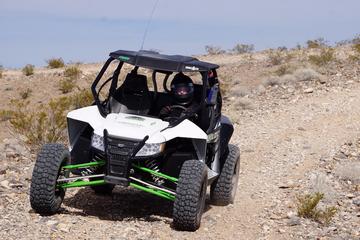

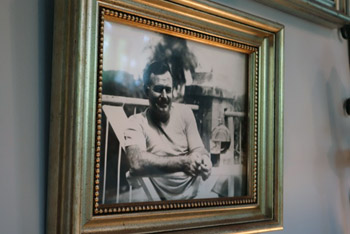 In 1928, Ernest Hemingway arrived at this tranquil island haven from Paris with his second wife, Pauline Pfeiffer, an accomplished journalist and contributor to Vogue Paris fashion magazine. The residence was a wedding gift from Pauline’s wealthy uncle Gus Pfeiffer, given to them in 1931.
In 1928, Ernest Hemingway arrived at this tranquil island haven from Paris with his second wife, Pauline Pfeiffer, an accomplished journalist and contributor to Vogue Paris fashion magazine. The residence was a wedding gift from Pauline’s wealthy uncle Gus Pfeiffer, given to them in 1931.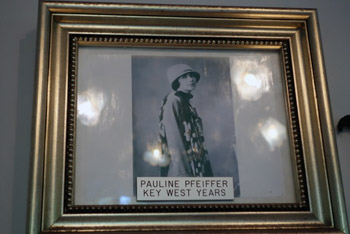 As I toured the house, you are immersed with Hemingway’s remarkable literary achievements. Each bedroom commemorates one of his great novels. The rooms are filled with personal mementos such as European hand carved antique furniture, life size trophy heads and animal skins from his African’s safaris and hunting trips from across the American west. He drew his inspiration for his boundless writings from many of these treasures.
As I toured the house, you are immersed with Hemingway’s remarkable literary achievements. Each bedroom commemorates one of his great novels. The rooms are filled with personal mementos such as European hand carved antique furniture, life size trophy heads and animal skins from his African’s safaris and hunting trips from across the American west. He drew his inspiration for his boundless writings from many of these treasures. The most lavish feature of his residence is the 60 foot long, 24 foot wide, 10 foot deep in-ground aqua blue colored swimming pool, carved from the same solid coral bedrock which Key West Island sits upon. In the 1930’s, no one had a swimming pool, as there was no fresh running water on the island. Therefore, the 80,000-gallon lighted swimming pool had to be filled by drilling down to the salt-water table and pumping the water into the pool. Filling the pool took nearly three days and during the summer months, salt water would only stay fresh for a few days. As a result, each week the pool had to be drained, the pool surfaces cleaned of algae, and then refilled again.
The most lavish feature of his residence is the 60 foot long, 24 foot wide, 10 foot deep in-ground aqua blue colored swimming pool, carved from the same solid coral bedrock which Key West Island sits upon. In the 1930’s, no one had a swimming pool, as there was no fresh running water on the island. Therefore, the 80,000-gallon lighted swimming pool had to be filled by drilling down to the salt-water table and pumping the water into the pool. Filling the pool took nearly three days and during the summer months, salt water would only stay fresh for a few days. As a result, each week the pool had to be drained, the pool surfaces cleaned of algae, and then refilled again. As I explored the residence grounds I came across several cats, all named after Hollywood stars from the 1930’s such as Humphrey Bogart and Ingrid Bergman. Hemingway’s household included a six-toed white cat named Snow White, which was given to him by a ship captain. Sailors considered these unique cats to be good luck, as they were very effective at catching vermin on board ships. Today, the only residences of The Hemingway Home and Museum are 47 polydactyl (six-toed) cats and it is believed that Snow White descendants live on the grounds today. Your average household cat has five front toes and four back toes. With the polydactyl gene in their DNA, that allows them to produce six-toed off spring.
As I explored the residence grounds I came across several cats, all named after Hollywood stars from the 1930’s such as Humphrey Bogart and Ingrid Bergman. Hemingway’s household included a six-toed white cat named Snow White, which was given to him by a ship captain. Sailors considered these unique cats to be good luck, as they were very effective at catching vermin on board ships. Today, the only residences of The Hemingway Home and Museum are 47 polydactyl (six-toed) cats and it is believed that Snow White descendants live on the grounds today. Your average household cat has five front toes and four back toes. With the polydactyl gene in their DNA, that allows them to produce six-toed off spring.
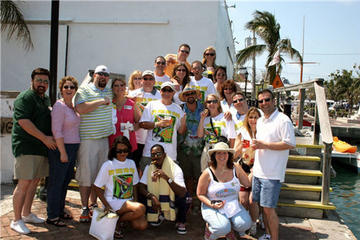
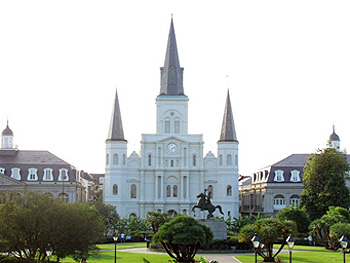
 New Orleans is known for many other things: seafood, e.g. crawfish, shrimp, crab and also for its music and musicians. The New Orleans area has the most home grown musicians in the country. They run the gamut from rock and roll, blues, jazz and even classical, from Fats Domino and Professor Longhair to Louie Prima and Louie Armstrong. However if New Orleans is known for anything it is a slogan and an attitude of, “Laissez les bons temps rouler, let the good times roll.” And that’s the truth! Ask any native New Orleanian.
New Orleans is known for many other things: seafood, e.g. crawfish, shrimp, crab and also for its music and musicians. The New Orleans area has the most home grown musicians in the country. They run the gamut from rock and roll, blues, jazz and even classical, from Fats Domino and Professor Longhair to Louie Prima and Louie Armstrong. However if New Orleans is known for anything it is a slogan and an attitude of, “Laissez les bons temps rouler, let the good times roll.” And that’s the truth! Ask any native New Orleanian. My wife and I visited the city of Slidell and our old neighborhood, New Orleans East and Downtown New Orleans. We had resided in Slidell, Louisiana located about 20 miles northeast of New Orleans from 1978-1984. We lived through two floods and two hurricanes, luckily none of which caused us any major problems, because we had boarded up the windows and battened down everything. The second hurricane was more severe than the first one and we did not get to sleep as the sound of the winds emanating from the storm kept us awake. They were howling at over 110 mph and sounded like a locomotive as the hurricane passed over us.
My wife and I visited the city of Slidell and our old neighborhood, New Orleans East and Downtown New Orleans. We had resided in Slidell, Louisiana located about 20 miles northeast of New Orleans from 1978-1984. We lived through two floods and two hurricanes, luckily none of which caused us any major problems, because we had boarded up the windows and battened down everything. The second hurricane was more severe than the first one and we did not get to sleep as the sound of the winds emanating from the storm kept us awake. They were howling at over 110 mph and sounded like a locomotive as the hurricane passed over us. The Slidell Memorial Hospital on Gause Blvd expanded in January 2011 with the opening of the Regional Cancer Center on Robert Blvd. Slidell has prospered since our last visit. There are many new commercial and business establishments. Some old ones are gone and new ones have taken their place.
The Slidell Memorial Hospital on Gause Blvd expanded in January 2011 with the opening of the Regional Cancer Center on Robert Blvd. Slidell has prospered since our last visit. There are many new commercial and business establishments. Some old ones are gone and new ones have taken their place.
 We drove through our old neighborhood which seems the less for wear. Talking with old friends and some of our old neighbors we learn that our old subdivision along Interstate 12 was spared the wrath of Katrina. There are new stores, gas stations and Brownswitch road one of the main routes now has a turnabout at Robert Road reflecting the growth in traffic patterns. Ah, progress.
We drove through our old neighborhood which seems the less for wear. Talking with old friends and some of our old neighbors we learn that our old subdivision along Interstate 12 was spared the wrath of Katrina. There are new stores, gas stations and Brownswitch road one of the main routes now has a turnabout at Robert Road reflecting the growth in traffic patterns. Ah, progress. New Orleans East & Metairie was hard hit by water. We drove down Read Blvd through the area where once stood the Lake Forest Mall in New Orleans East. The huge complex is gone, and a building on the Interstate 10 frontage road where I where I was employed for a time is now four walls and gutted. You can see through it, some of the windows are broken. I also remember a restaurant down the street, a Denny’s I believe. It is now gone. Katrina did it all.
New Orleans East & Metairie was hard hit by water. We drove down Read Blvd through the area where once stood the Lake Forest Mall in New Orleans East. The huge complex is gone, and a building on the Interstate 10 frontage road where I where I was employed for a time is now four walls and gutted. You can see through it, some of the windows are broken. I also remember a restaurant down the street, a Denny’s I believe. It is now gone. Katrina did it all. Play tourist and enjoy the ambiance of what New Orleans has to offer. There is a different feeling about visiting downtown New Orleans as a tourist compared to living there and visiting. Stop at historic Jackson Square and enjoy. It was originally known in the 18th century as “Place d’Armes,” and later renamed in honor of the hero of the Battle of New Orleans, Andrew Jackson. It is a timeless attraction in the heart of the French Quarter of New Orleans. There is a different view, tourists are everywhere, we walk through the cobbled streets and stop and listen to a jam session featuring a group of Jazz musicians performing, “When the Saints Go Marching In.” Canal Street is still vibrant and St Louis Cathedral is peaceful. We visit Harrah’s Casino to try our luck. We pass by a familiar face, the Superdome still intact, looking like a gigantic flying saucer. It is good to see some of our old memories.
Play tourist and enjoy the ambiance of what New Orleans has to offer. There is a different feeling about visiting downtown New Orleans as a tourist compared to living there and visiting. Stop at historic Jackson Square and enjoy. It was originally known in the 18th century as “Place d’Armes,” and later renamed in honor of the hero of the Battle of New Orleans, Andrew Jackson. It is a timeless attraction in the heart of the French Quarter of New Orleans. There is a different view, tourists are everywhere, we walk through the cobbled streets and stop and listen to a jam session featuring a group of Jazz musicians performing, “When the Saints Go Marching In.” Canal Street is still vibrant and St Louis Cathedral is peaceful. We visit Harrah’s Casino to try our luck. We pass by a familiar face, the Superdome still intact, looking like a gigantic flying saucer. It is good to see some of our old memories.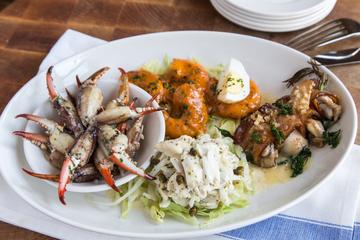
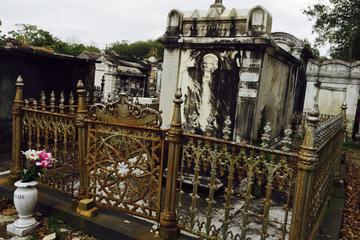
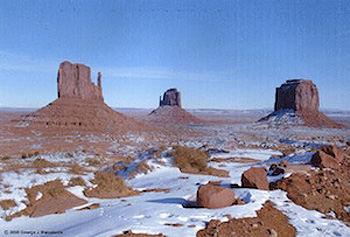
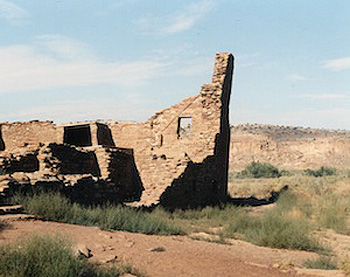 Chaco Canyon National Historical Park sits in Northwestern New Mexico and was designated as a World Heritage Site in 1987. According to archeological studies, 4,000 to 6,000 Hopi, Pueblo, Navajo and other Indian tribes passed through this canyon. From 850 A.D. to 1150 A.D., the Anasazi lived within great houses often oriented to solar, lunar and cardinal directions. There seems to be an unending fascination about the Anasazi’s and their use of sophisticated astronomical markers, water control devices and Chacon “roads.” At the Chaco Canyon visitor center a video program is shown hourly about these ancient inhabitants as well as a small museum displaying artifacts, maps and a small outdoor observatory.
Chaco Canyon National Historical Park sits in Northwestern New Mexico and was designated as a World Heritage Site in 1987. According to archeological studies, 4,000 to 6,000 Hopi, Pueblo, Navajo and other Indian tribes passed through this canyon. From 850 A.D. to 1150 A.D., the Anasazi lived within great houses often oriented to solar, lunar and cardinal directions. There seems to be an unending fascination about the Anasazi’s and their use of sophisticated astronomical markers, water control devices and Chacon “roads.” At the Chaco Canyon visitor center a video program is shown hourly about these ancient inhabitants as well as a small museum displaying artifacts, maps and a small outdoor observatory. Self-guided tours are also available to the grand Pueblo Bonito, (Spanish for Beautiful Town) the largest Anasazi ruin, Casa Rinconado (Great Kiva) and Una Vida (another great house). For longer treks, there are at least a dozen trails leading to the top of the mesa for views of the entire Chaco Canyon network of ruins. Most are fairly easy with little elevation gain, the longest trail is a little over six miles. We chose the Pueblo Bonito Rim Overlook trail. After a steep one and a half mile climb the ruins of Pueblo Alto greeted us as a setting sun shadow danced across the canyon walls.
Self-guided tours are also available to the grand Pueblo Bonito, (Spanish for Beautiful Town) the largest Anasazi ruin, Casa Rinconado (Great Kiva) and Una Vida (another great house). For longer treks, there are at least a dozen trails leading to the top of the mesa for views of the entire Chaco Canyon network of ruins. Most are fairly easy with little elevation gain, the longest trail is a little over six miles. We chose the Pueblo Bonito Rim Overlook trail. After a steep one and a half mile climb the ruins of Pueblo Alto greeted us as a setting sun shadow danced across the canyon walls. Canyon De Chelly National Monument resides in Northeast Arizona and is west of Chaco Canyon. Numerous overlooks of the canyon are accessible by driving a two-lane road that meanders along the rim. My favorite overlook was Spider Rock. Today, only two tall spires of red sandstone stand alone in the middle of the valley floor depicting Spider Woman’s home where she helped her People move into the fourth world by hiding them in the reeds and then floating them down to dry land.
Canyon De Chelly National Monument resides in Northeast Arizona and is west of Chaco Canyon. Numerous overlooks of the canyon are accessible by driving a two-lane road that meanders along the rim. My favorite overlook was Spider Rock. Today, only two tall spires of red sandstone stand alone in the middle of the valley floor depicting Spider Woman’s home where she helped her People move into the fourth world by hiding them in the reeds and then floating them down to dry land.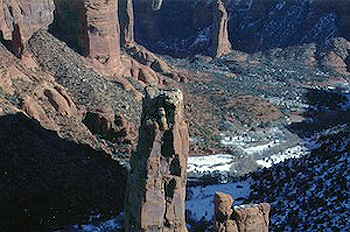 The Second World according to Waters was called “Dark Midnight” and was destroyed by cold and ice. Again, the kivas kept them warm and dry. Once the destruction stopped, they climbed up a ladder into another world. This was the Third World. Dissension broke out quickly among the People and this world was destroyed by flooding. However, this time an appointed caretaker named Spider Woman saved the ancients by hiding them in reeds and floating them to dry land into the Fourth World. The Fourth World, according to Waters, was called “World Complete.” This world was unlike the previous three, where the ancestors were provided for. The Fourth World had harsh deserts, never ending marshes and mountains of violent weather. This World was to be a time of awakening, realizing how we affect each other and that we are all one. Sounds like what might be happening now, doesn’t it? The Hopi say we are now living in the Fourth world which is ending and that the Fifth World is beginning.
The Second World according to Waters was called “Dark Midnight” and was destroyed by cold and ice. Again, the kivas kept them warm and dry. Once the destruction stopped, they climbed up a ladder into another world. This was the Third World. Dissension broke out quickly among the People and this world was destroyed by flooding. However, this time an appointed caretaker named Spider Woman saved the ancients by hiding them in reeds and floating them to dry land into the Fourth World. The Fourth World, according to Waters, was called “World Complete.” This world was unlike the previous three, where the ancestors were provided for. The Fourth World had harsh deserts, never ending marshes and mountains of violent weather. This World was to be a time of awakening, realizing how we affect each other and that we are all one. Sounds like what might be happening now, doesn’t it? The Hopi say we are now living in the Fourth world which is ending and that the Fifth World is beginning.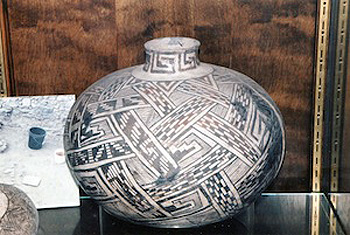 Further south of Canyon De Chelly lies Casa Malpais Archaeological Park. This National Historic Landmark also has evidence of underworld activity within the ruins. Intact pottery was discovered here as well as a 8 X 4 foot panel depicting human like figures with tails which may have represented ancestral beings before they emerged above ground to the fourth world. These petroglyphs offer an inkling about the Zuni and Hopi clans that lived and held ceremonies here six hundred years ago. Archeologists propose these drawings came from the Parrot Clans because there is a parrot spitting rainwater onto a corn plant. According to Hopi legends, this indicates that the Corn Clan and Parrot Clan went their separate ways.
Further south of Canyon De Chelly lies Casa Malpais Archaeological Park. This National Historic Landmark also has evidence of underworld activity within the ruins. Intact pottery was discovered here as well as a 8 X 4 foot panel depicting human like figures with tails which may have represented ancestral beings before they emerged above ground to the fourth world. These petroglyphs offer an inkling about the Zuni and Hopi clans that lived and held ceremonies here six hundred years ago. Archeologists propose these drawings came from the Parrot Clans because there is a parrot spitting rainwater onto a corn plant. According to Hopi legends, this indicates that the Corn Clan and Parrot Clan went their separate ways.



